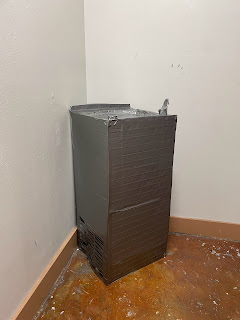Sunday, October 30, 2022
Experimental Sculpture Collection Photos
To Have and To Hold Presentation
The Ark Abducted
-John Tradescant The Elder, famous naturalist, gardener, traveler, and collector of strange plants and oddities
-Gardener for royals
-He created “The Ark” which was a museum of sorts and a Cabinet of Curiosity featuring seeds and bulbs from all of his travels
-The Ark was the first museum ever opened to the public in England in the early 17th Century
-The museum became famous all over Europe
-Tradescant knew that unicorn horns were all the rage, so he got one for his museum and cataloged it
-A frequent visitor, Elias Ashmole convinced John the Younger (John Tradescant The Elder’s son) that they should let him take over the museum since John the Younger and his wife, Hester, were suffering from the loss of their son
-Hester did not like this idea, and a feud began between her and Ashmole
-John the Younger willed all the items in the museum to Hester and after she died the items could go to the Universities of Oxford or Cambridge
-Ashmole took Hester to court, and he won the case; he had all of the items
-Hester died from drowning in her pond, and Ashmole took all of the remaining items
-Later he decided to give up all the items to Oxford University where you can still see some items today
The Exquisite Art of Dr. Ruysch
-The chapter opens with a description of a painting, a painting of a dissection of an infant by Dr. Frederik Ruysch
-Anatomists at the time of the 17th century were fascinated with mortality and the idea that bodies themselves could be objects, dead matter
-Public dissections of criminals were a form of entertainment
-These dissections were theatrical; dissections were seen as a valuable moral lesson
-Dr. Ruysch was the most important anatomist during this time, and he had performed over thirty public dissections in his 93 years
-During the summer, dissections couldn't be performed without it being too smelly; the operating room was transformed into a cabinet of rarities during the summer months
-After 1620 the venue was expanded into a true cabinet of curiosity with all sorts of oddities and rarities with even mummies on display from Egypt
-Theatrum anatomicum, the art of the anatomical artist, became so widespread because this was a time when death was everywhere, and people were curious about the inner workings of our bodies
-Tsar Peter the Great had a fascination with the rare and odd, collecting dwarfs and caging them, extracting teeth from people who would pass by, and spending large amounts of money on collections
Cabinet of Curiosity
Organic Materials: Fabric, black foam board, straight pins, wood, air dry clay, resin teeth, colored thread, twin, black masking tape 14...

-
The Ark Abducted -John Tradescant The Elder, famous naturalist, gardener, traveler, and collector of strange plants and oddities -Gardener f...
-
https://art21.org/watch/new-york-close-up/marela-zacariass-great-expectations/ Marela Zacarias Unpredictable / Forever Growing http://mare...
-
1: "The souvenir speaks to a context of origin through a language of longing." This is a picture of my best friend and me in our S...




























